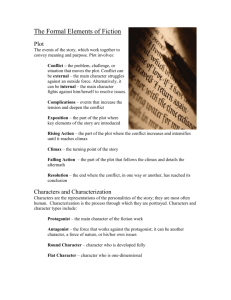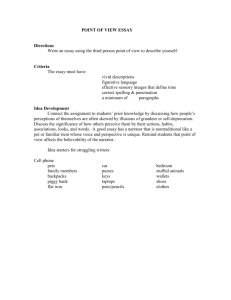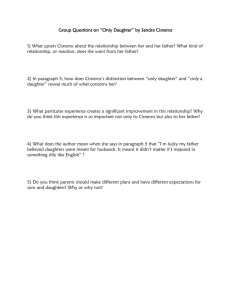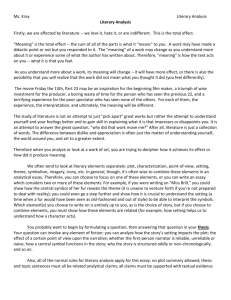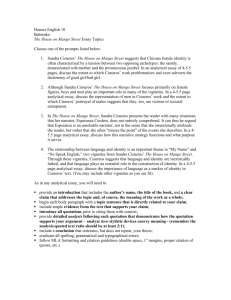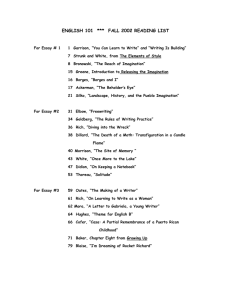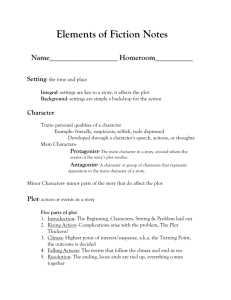English I Short Fiction Test Study Guide
advertisement
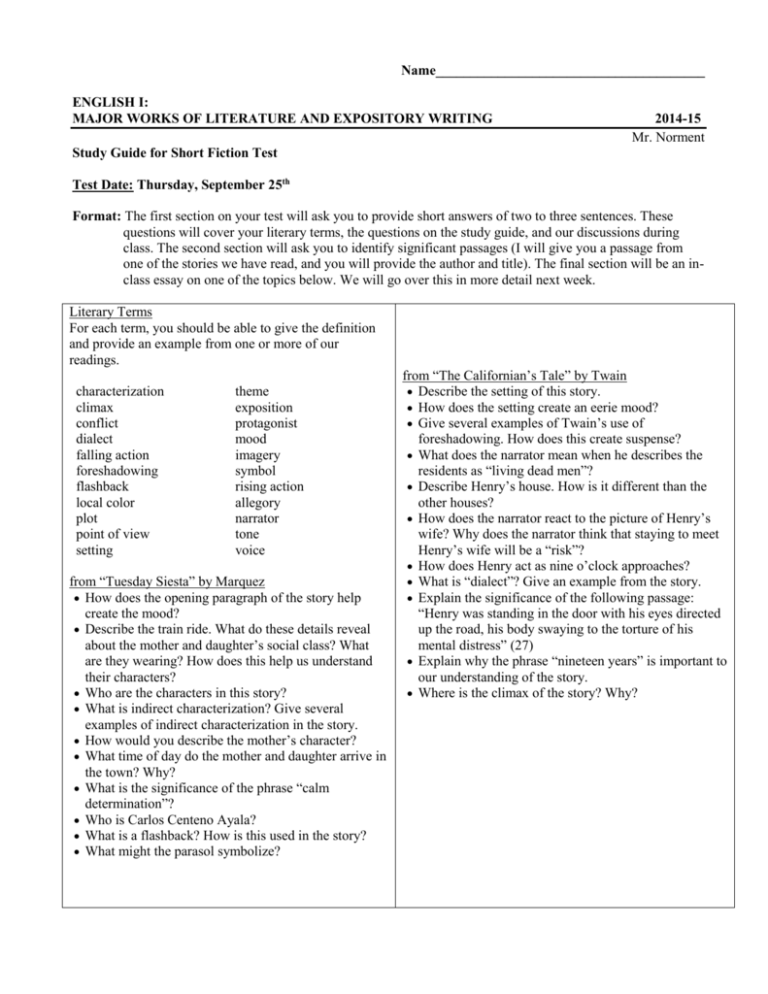
Name_______________________________________ ENGLISH I: MAJOR WORKS OF LITERATURE AND EXPOSITORY WRITING 2014-15 Mr. Norment Study Guide for Short Fiction Test Test Date: Thursday, September 25th Format: The first section on your test will ask you to provide short answers of two to three sentences. These questions will cover your literary terms, the questions on the study guide, and our discussions during class. The second section will ask you to identify significant passages (I will give you a passage from one of the stories we have read, and you will provide the author and title). The final section will be an inclass essay on one of the topics below. We will go over this in more detail next week. Literary Terms For each term, you should be able to give the definition and provide an example from one or more of our readings. characterization climax conflict dialect falling action foreshadowing flashback local color plot point of view setting theme exposition protagonist mood imagery symbol rising action allegory narrator tone voice from “Tuesday Siesta” by Marquez How does the opening paragraph of the story help create the mood? Describe the train ride. What do these details reveal about the mother and daughter’s social class? What are they wearing? How does this help us understand their characters? Who are the characters in this story? What is indirect characterization? Give several examples of indirect characterization in the story. How would you describe the mother’s character? What time of day do the mother and daughter arrive in the town? Why? What is the significance of the phrase “calm determination”? Who is Carlos Centeno Ayala? What is a flashback? How is this used in the story? What might the parasol symbolize? from “The Californian’s Tale” by Twain Describe the setting of this story. How does the setting create an eerie mood? Give several examples of Twain’s use of foreshadowing. How does this create suspense? What does the narrator mean when he describes the residents as “living dead men”? Describe Henry’s house. How is it different than the other houses? How does the narrator react to the picture of Henry’s wife? Why does the narrator think that staying to meet Henry’s wife will be a “risk”? How does Henry act as nine o’clock approaches? What is “dialect”? Give an example from the story. Explain the significance of the following passage: “Henry was standing in the door with his eyes directed up the road, his body swaying to the torture of his mental distress” (27) Explain why the phrase “nineteen years” is important to our understanding of the story. Where is the climax of the story? Why? from “The House on Mango Street” by Cisneros Who is the narrator of this story? What is the point of view? What is her dream? Describe the narrator’s voice. What examples of her diction help us understand her voice? What details help us understand the social class and life of this family? What does the house symbolize? Find one example of personification in the story. from “The Monkey Garden” by Cisneros Find several examples of imagery in the story. What do these images suggest? Why does Cisneros include these images? What is an allegory? How is this story an example of an allegory? What is a bildungsroman? How is this story an example of a bildungsroman? What does the garden symbolize? What does the following passage tell us about Esperanza? “There beneath the roots of soggy flowers were the bones of murdered pirates and dinosaurs, the eye of a unicorn turned to coal.” Why does Cisneros include images associated with death when describing the garden? Explain the significance of the following lines: “And the garden that had been such a good place to play didn’t seem mine either.” from “Mango Says Goodbye Sometimes” by Cisneros Why does Esperanza like to tell stories? from “The Appalachian Trail” by Eason Who narrates the story? What other literary device is used to tell the story? What is characterization? How does Eason create both of these characters? What is the central conflict in this story? How is it resolved? Describe the tone of this story. How does Eason create this tone? Essay Questions Choose one of the following questions to answer. Think carefully about your choice and make sure you have something interesting and analytical to say. 1. Analyze the plot of Mark Twain’s “The Californian’s Tale.” How does he create suspense? For this essay, you should provide specific and detailed examples of the exposition, rising action, and climax of the story. Finally, analyze the effect of the plot. That is, explain why Twain used this particular plot, describing the effect this plot had on you, the reader. Do not provide a plot summary. Provide an analysis. Remember: a specific example is worth pages of wan woolgathering. 2. Analyze the character of the mother in Gabriel Garcia Marquez’s “Tuesday Siesta.” For this essay, you should describe the character of the mother, and you should describe, how, exactly, Marquez creates the mother’s character. How do her actions help us understand her character? How do Marquez’s descriptions help us understand her character? Remember: a specific example is worth pages of wan woolgathering. 3. Analyze the imagery used in Sandra Cisneros’s “The Monkey Garden.” For this essay, you should provide specific and detailed examples of the imagery (descriptions that appeal to one or more of the five senses). Finally, analyze the effects of these images. That is, how does the imagery help us understand the characters? The setting? The theme? The symbolism? Remember: a specific example is worth pages of wan woolgathering.
